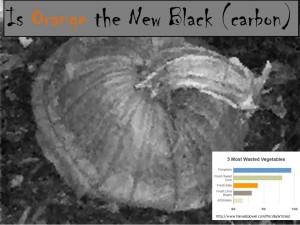Fall is a gorgeous time of year in the Finger Lakes. One of the prettiest things to see, besides the stunning fall foliage, is the site of so many pumpkin patches dotting the landscape. Generally one of the top five producers of pumpkins in the US, New York harvests roughly 50,000 tons of mostly ornamental pumpkins from 7,000 acres which nets farmers a chilling $25M. On a micro scale that translates to: ~7 t/acre at $500/t or $3,500/t per acre. Not a bad revenue per acre for an annual crop! On a macro scale, Americans grow 1.5 BILLION pounds of pumpkins per year.
Rarely have I given much thought to the afterlife of pumpkins but now that I’ve become such a waste hunter, I always seem to be pondering what heaven looks like for various types of biomass. For pumpkins it seems that come All Souls Day, the fate for most of those lovingly carved globes is a rather unglamorous trip to the local landfill. Yep, that’s right. Unlike their tasty cousins grown in Illinois which are destined for pumpkin pies, the ornamentals get chucked in the dump where they turn into something far scarier…methane! If you bury pumpkins and starve them of oxygen, their gaseous ghosts will continue to haunt us all long past their prime.
Although there are ways to delay the trek to the dump what I wanted to know is this: could all that pumpkin waste be used as a feedstock for biochar? Given that the moisture content of pumpkin guts (ok if you want to get technical, the shell, pulp or fibrous strands) is really high (probably ~90%), that part of the pumpkin is, unfortunately, not really a likely target for biochar unless you dehydrate it, which is normally a fairly energy intensive process. But hey, maybe California could collect and ‘squash’ all those discarded pumpkins to recycle all that water for irrigation! With 1.5 Billion pounds * 90% water we are talking a LOT of water!!
Not one to give up on any biomass as a biochar prospect, I came across some articles that claim that the stems or seeds of pumpkins have been turned into activated carbon which is useful as an absorbent for toxins. This of course leads me to think that biochar made from certain pumpkin parts might not be a bad idea. But really who is going to go out separating all those stems from all those pumpkins? Perhaps this is a job for the headless horseman but not for me!
As I was trying to think up a ‘Boo-char’ experiment for this year, I settled on this: why not fill up a pumpkin that has had its innards outed (so I can toast the seeds and maybe, just maybe, char a few) with biochar and see what happens over the winter to the char-filled pumpkin. Maybe it will act as a desiccant and dry it out. Maybe it will prevent it from molding. Or maybe it will turn it into black cauldron! We shall see..


